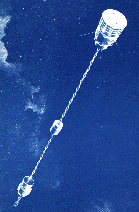|
(Files in red–history) |
If the orbit were entirely determined by the Earth's gravity, it would be easy to calculate and predict. At low altitudes, however, the air resistance from the fringes of the atmosphere is not entirely negligible, and neither it nor the effect of sunlight pressure can be accurately predicted. Triad had floating inside it a "proof mass," a gold-platinum sphere about an inch across, which, being completely enclosed, was affected neither by air resistance nor by sunlight. Even the feeble gravitational attraction of the rest of the satellite was taken into account, by moving the power supply, radio etc. (including the magnetometer) to the ends of two long booms, on opposite sides of the "proof mass". While the "proof mass" thus moved in an accurately predictable orbit, the spacecraft itself was subject to air resistance and sunlight pressure, causing it to move slightly differently. Electronic sensors would note when the floating ball approached one of the walls of its "cage", and thrustors would be fired to move the spacecraft away from the ball. By thus matching its motion to that of the "proof mass", the satellite moved as if no extra disturbing forces existed.
|
